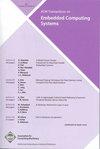Proactive Stripe Reconstruction to Improve Cache Use Efficiency of SSD-Based RAID Systems
IF 2.6
3区 计算机科学
Q2 COMPUTER SCIENCE, HARDWARE & ARCHITECTURE
引用次数: 0
Abstract
Solid-State Drives (SSDs) exhibit different failure characteristics compared to conventional hard disk drives. In particular, the Bit Error Rate (BER) of an SSD increases as it bears more writes. Then, Parity-based Redundant Array of Inexpensive Disks (RAID) arrays composed from SSDs are introduced to address correlated failures. In the RAID-5 implementation, specifically, the process of parity generation (or update) associating with a data stripe, consists of read and write operations to the SSDs. Whenever a new update request comes to the RAID system, the related parity must be also updated and flushed onto the RAID component of SSD. Such frequent parity updates result in poor RAID performance and shorten the life-time of the SSDs. Consequently, a DRAM cache is commonly equipped accompanying with the RAID controller, called the parity cache, and used to buffer the parity chunks that are most frequently updated data, for boosting I/O performance. To better improve the use efficiency of the parity cache, this paper proposes a stripe reconstruction approach to minimize the number of parity updates on SSDs, thus boosting I/O performance of the SSD RAID system. When the currently updated stripe has both cold and hot updated data chunks, it will proactively carry out stripe reconstruction if we can find another matched stripe that also includes cold and hot update data chunks on the complementary RAID components. In the reconstruction process, we first group the cold data chunks of two matched stripes, to build a new stripe and flush the parity chunk on the RAID component. After that, the hot data chunks are organized as a new stripe as well, and its parity chunk is buffered in the parity cache. This results in better cache use efficiency, as it can reduce the number of parity updates on RAID components of SSDs, as well as proactively free up cache space for quickly absorbing subsequent write requests. In addition, the proposed method adjusts the target SSD of write requests based on stripe reconstructions through considering the I/O workload balance of all SSDs. Experimental results show that our proposal can reduce the number of parity chunk updates in SSDs by 2.3% and overall I/O latency by 12.2% on average, compared to state-of-the-art parity cache management techniques.主动分条重构提高ssd RAID系统缓存利用率
与传统硬盘驱动器相比,固态硬盘驱动器(ssd)具有不同的故障特征。特别是,随着写入次数的增加,SSD的误码率也会增加。然后,引入由ssd组成的基于奇偶校验的RAID (Redundant Array of Inexpensive Disks)阵列来解决相关故障。在RAID-5实现中,与数据分条相关联的奇偶校验生成(或更新)过程包括对ssd硬盘的读和写操作。每当新的更新请求到达RAID系统时,相关的奇偶校验也必须更新并刷新到SSD的RAID组件上。频繁的奇偶校验更新会导致RAID性能下降,缩短ssd寿命。因此,DRAM缓存通常与RAID控制器一起配备,称为奇偶校验缓存,用于缓冲最频繁更新的数据奇偶校验块,以提高I/O性能。为了更好地提高奇偶校验缓存的使用效率,本文提出了一种条带重构方法,以减少SSD上的奇偶校验更新次数,从而提高SSD RAID系统的I/O性能。当当前更新的分条同时存在冷更新数据块和热更新数据块时,如果在互补RAID组件上找到另一个匹配的分条,同时存在冷更新数据块和热更新数据块,则会主动进行分条重构。在重构过程中,我们首先将两个匹配条带的冷数据块分组,建立一个新的条带,并在RAID组件上刷新校验块。之后,热数据块也被组织成一个新的分条,其奇偶校验块被缓冲在奇偶校验缓存中。这可以提高缓存使用效率,因为它可以减少ssd RAID组件上的奇偶更新次数,并主动释放缓存空间,以便快速吸收后续的写请求。此外,该方法通过考虑所有SSD的I/O负载均衡,根据分条重构调整写请求的目标SSD。实验结果表明,与最先进的奇偶校验缓存管理技术相比,我们的建议可以将ssd中的奇偶校验块更新次数减少2.3%,总体I/O延迟平均减少12.2%。
本文章由计算机程序翻译,如有差异,请以英文原文为准。
求助全文
约1分钟内获得全文
求助全文
来源期刊

ACM Transactions on Embedded Computing Systems
工程技术-计算机:软件工程
CiteScore
3.70
自引率
0.00%
发文量
138
审稿时长
6 months
期刊介绍:
The design of embedded computing systems, both the software and hardware, increasingly relies on sophisticated algorithms, analytical models, and methodologies. ACM Transactions on Embedded Computing Systems (TECS) aims to present the leading work relating to the analysis, design, behavior, and experience with embedded computing systems.
 求助内容:
求助内容: 应助结果提醒方式:
应助结果提醒方式:


